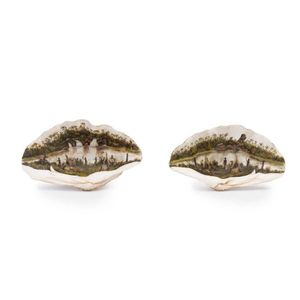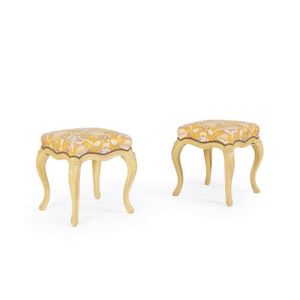Louis XVI Yellow Painted Stools with Elaborate Carvings
You must be a subscriber, and be logged in to view price and dealer details.
Subscribe Now to view actual auction price for this item
When you subscribe, you have the option of setting the currency in which to display prices to $Au, $US, $NZ or Stg.
- Provenance - A term used to describe the provable history of an antique or work of art, and thus an additional aid to verifying its authenticity. Provenance can have an inflating effect on the price of an item, particularly if the provenance relates to the early settlement of Australia, a famous person, or royalty. Less significant are previous sales of the item through an auction house or dealer.
- Cabriole Leg - The cabriole leg evolved from an elongated scroll, curving out at the knee which may or may not be carved, and forming a serpentine shape as it descends to the foot.
First introduced into English furniture in the late 17th century, cabriole legs were widely used during the Queen Anne and early Georgian periods, where they frequently terminated in a pad foot or ball and claw foot. The style has had many imitators since then. The cabriole leg was re-introduced in the mid-19th century, and is commonly associated with the balloon-back dining or drawing-room chairs made in walnut, mahogany or, in Australia, cedar. The Victorian cabriole leg, on the whole, was rather more slender than the earlier form, following the French style, which emphasized the delicacy and daintiness of the chairs they were designed to support. Cabriole legs are sometimes found on windsor chairs, especially those made during the 18th century.
This item has been included into following indexes:
- stools, origin - French 103
- stools, period or age - Georgian 89
-
stools, type or function
- cabriole leg 67
- upholstered 338
Visually similar items

Quartz cocktail ring, large oval quartz claw set in a 9ct yellow gold featuring a scrolled design frame, approx. Weight 7.4 grams size J

A pair of rare and important hand painted clam shells depicting North Queensland Aboriginal scenes, 19th century, monogrammed M.G. approximate size 17 x 27 cm each

A Chinese carved ivory boat carrying the eight immortals on the high Seas, each of the figures seated or standing holding their various attributes, on fitted black wood stand, length 32 cm height 9 cm

A white opal princess ring. 14ct yellow gold. Weight 9 grams. Size N.
